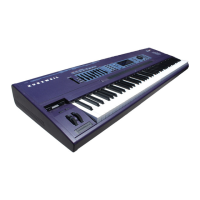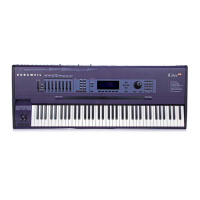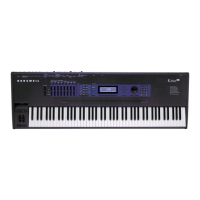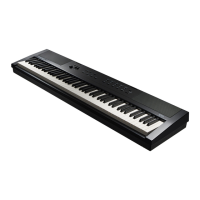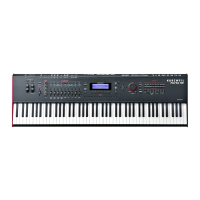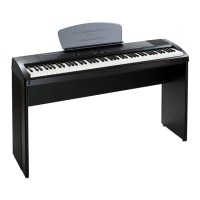Advanced KDFX
Using the Algorithms
15-35
Using the Algorithms
This section will discuss the processing algorithms found in KDFX: what their parameters mean,
and how to use them. It is designed to be read through so that you can get a general
understanding of the algorithms. You can Þnd a more complete reference, with every algorithm
and the meaning and range of every parameter, arranged in the order they appear on the screen,
in the MusicianÕs Reference.
But Þrst, a word about how the KDFX studios in ROM are organized.
Conventional Studio Structure
Many of the studios provided in ROM follow an overall organizational plan, which uses KDFXÕs
resources efÞciently and clearly. While by no means are you required to follow this structure
when creating your own studios, itÕs a good idea to become familiar with it, and see how
KurzweilÕs own engineers have approached the complex issue of studio organization. And
certainly it can serve as a good starting point when you start creating your own studios.
The organization of the ROM studios follows the following guidelines Not all studios are set up
this way, but most of them are.
¥ ROM programs and setups are assigned to an output (KDFX-A through KDFX-D on the
Program:Output or Setup:CH/PRG page) based on the type of effects processing that would
most likely be appropriate for that sound.
¥ All inputs go to their respective FXBuses (Input A to FXBus 1, Input B to FXBus 2, etc.), and
only to their respective FXBusesÑthe Lvl parameter for the second FXBus on each Input
page is turned Off.
¥ FXBus1 contains a relatively simple reverb with a low Size requirement.
¥ FXBus2 contains an effect that does not increase the ÒlengthÓ of the sound (that is, no reverb
or delay). Possibilities include chorus, ßange, phaser, distortion, shaper, pitcher, enhancer,
EQ, or EQ morpher.
¥ FXBus3 contains effects that take up lots of time, such as delays, delays with reverb, or other
lead sounds.
¥ FXBus4 is dry, since the Þrst three FXBuses have probably used up all the PAUs.
¥ The Aux bus contains a larger reverb (Size: 2 or 3), a compressor, or a graphic EQ. It can
often be used instead of an FXBus reverb, such as the one on FXBus1. If you use it in this
way (set the Aux Lvl on FXBus1 to 0dB or higher), it frees up FXBus1 for use as an Enhancer,
Stereo Image, Flanger, etc.
General Parameters
Some parameters show up in all algorithms, and weÕll deal with those Þrst.
Wet/Dry balances the levels of the processed and unprocessed signals passing through the
FXpreset. The range is 0% wet (the signal is unprocessed) through 100% wet (no dry signal is
present). A setting of 50% wet means the dry and processed signals are equal in level. In some
algorithms, separate Wet/Dry parameters are provided for the Left and Right input channels.
In Gain sets the level of the signal coming into the FXpreset from the Input page. As with most
Gain controls in KDFX, the range is -79.0 dB to 24.0 dB, and there is an Off position. 0.0 dB is
unity gain.
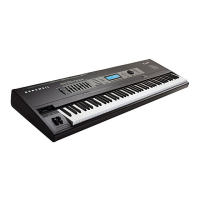
